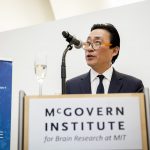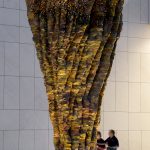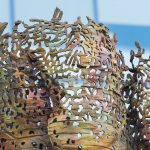“Serial-like sampling of visual objects during sustained attention”
Huan Luo, IDG/McGovern Institute, Peking University
November 8, 2016
Category: Uncategorized
2016 Joint IDG/McGovern Institutes Symposium: Guoping Feng
“Thalamic Reticular Nucleus (TRN) Dysfunction in Neurodevelopmental Disorders”
Guoping Feng, McGovern Institute for Brain Research at MIT
November 8, 2016
2016 Joint IDG/McGovern Institutes Symposium: Jing Yang
“A metabolic view of pathological axon degeneration”
Jing Yang, IDG/McGovern Institute, Peking University
November 8, 2016
2016 Joint IDG/McGovern Institutes Symposium: Yong Zhang
“Visualizing AMPA receptor synaptic plasticity in vivo”
Yong Zhang, IDG/McGovern Institute, Peking University
November 8, 2016
2016 Joint IDG/McGovern Institutes Symposium: Yina Ma
“Oxytocin and social adaption”
Yina Ma, IDG/McGovern Institute, Beijing Normal University
November 8, 2016
A radiation-free approach to imaging molecules in the brain
Scientists hoping to get a glimpse of molecules that control brain activity have devised a new probe that allows them to image these molecules without using any chemical or radioactive labels.
Currently the gold standard approach to imaging molecules in the brain is to tag them with radioactive probes. However, these probes offer low resolution and they can’t easily be used to watch dynamic events, says Alan Jasanoff, an MIT professor of biological engineering.
Jasanoff and his colleagues have developed new sensors consisting of proteins designed to detect a particular target, which causes them to dilate blood vessels in the immediate area. This produces a change in blood flow that can be imaged with magnetic resonance imaging (MRI) or other imaging techniques.
“This is an idea that enables us to detect molecules that are in the brain at biologically low levels, and to do that with these imaging agents or contrast agents that can ultimately be used in humans,” Jasanoff says. “We can also turn them on and off, and that’s really key to trying to detect dynamic processes in the brain.”
In a paper appearing in the Dec. 2 issue of Nature Communications, Jasanoff and his colleagues used these probes to detect enzymes called proteases, but their ultimate goal is to use them to monitor the activity of neurotransmitters, which act as chemical messengers between brain cells.
The paper’s lead authors are postdoc Mitul Desai and former MIT graduate student Adrian Slusarczyk. Recent MIT graduate Ashley Chapin and postdoc Mariya Barch are also authors of the paper.
Indirect imaging
To make their probes, the researchers modified a naturally occurring peptide called calcitonin gene-related peptide (CGRP), which is active primarily during migraines or inflammation. The researchers engineered the peptides so that they are trapped within a protein cage that keeps them from interacting with blood vessels. When the peptides encounter proteases in the brain, the proteases cut the cages open and the CGRP causes nearby blood vessels to dilate. Imaging this dilation with MRI allows the researchers to determine where the proteases were detected.
“These are molecules that aren’t visualized directly, but instead produce changes in the body that can then be visualized very effectively by imaging,” Jasanoff says.
Proteases are sometimes used as biomarkers to diagnose diseases such as cancer and Alzheimer’s disease. However, Jasanoff’s lab used them in this study mainly to demonstrate the validity their approach. Now, they are working on adapting these imaging agents to monitor neurotransmitters, such as dopamine and serotonin, that are critical to cognition and processing emotions.
To do that, the researchers plan to modify the cages surrounding the CGRP so that they can be removed by interaction with a particular neurotransmitter.
“What we want to be able to do is detect levels of neurotransmitter that are 100-fold lower than what we’ve seen so far. We also want to be able to use far less of these molecular imaging agents in organisms. That’s one of the key hurdles to trying to bring this approach into people,” Jasanoff says.
Jeff Bulte, a professor of radiology and radiological science at the Johns Hopkins School of Medicine, described the technique as “original and innovative,” while adding that its safety and long-term physiological effects will require more study.
“It’s interesting that they have designed a reporter without using any kind of metal probe or contrast agent,” says Bulte, who was not involved in the research. “An MRI reporter that works really well is the holy grail in the field of molecular and cellular imaging.”
Tracking genes
Another possible application for this type of imaging is to engineer cells so that the gene for CGRP is turned on at the same time that a gene of interest is turned on. That way, scientists could use the CGRP-induced changes in blood flow to track which cells are expressing the target gene, which could help them determine the roles of those cells and genes in different behaviors. Jasanoff’s team demonstrated the feasibility of this approach by showing that implanted cells expressing CGRP could be recognized by imaging.
“Many behaviors involve turning on genes, and you could use this kind of approach to measure where and when the genes are turned on in different parts of the brain,” Jasanoff says.
His lab is also working on ways to deliver the peptides without injecting them, which would require finding a way to get them to pass through the blood-brain barrier. This barrier separates the brain from circulating blood and prevents large molecules from entering the brain.
The research was funded by the National Institutes of Health BRAIN Initiative, the MIT Simons Center for the Social Brain, and fellowships from the Boehringer Ingelheim Fonds and the Friends of the McGovern Institute.
Researchers create synthetic cells to isolate genetic circuits
Synthetic biology allows scientists to design genetic circuits that can be placed in cells, giving them new functions such as producing drugs or other useful molecules. However, as these circuits become more complex, the genetic components can interfere with each other, making it difficult to achieve more complicated functions.
MIT researchers have now demonstrated that these circuits can be isolated within individual synthetic “cells,” preventing them from disrupting each other. The researchers can also control communication between these cells, allowing for circuits or their products to be combined at specific times.
“It’s a way of having the power of multicomponent genetic cascades, along with the ability to build walls between them so they won’t have cross-talk. They won’t interfere with each other in the way they would if they were all put into a single cell or into a beaker,” says Edward Boyden, an associate professor of biological engineering and brain and cognitive sciences at MIT. Boyden is also a member of MIT’s Media Lab and McGovern Institute for Brain Research, and an HHMI-Simons Faculty Scholar.
This approach could allow researchers to design circuits that manufacture complex products or act as sensors that respond to changes in their environment, among other applications.
Boyden is the senior author of a paper describing this technique in the Nov. 14 issue of Nature Chemistry. The paper’s lead authors are former MIT postdoc Kate Adamala, who is now an assistant professor at the University of Minnesota, and former MIT grad student Daniel Martin-Alarcon. Katriona Guthrie-Honea, a former MIT research assistant, is also an author of the paper.
Circuit control
The MIT team encapsulated their genetic circuits in droplets known as liposomes, which have a fatty membrane similar to cell membranes. These synthetic cells are not alive but are equipped with much of the cellular machinery necessary to read DNA and manufacture proteins.
By segregating circuits within their own liposomes, the researchers are able to create separate circuit subroutines that could not run in the same container at the same time, but can run in parallel to each other, communicating in controlled ways. This approach also allows scientists to repurpose the same genetic tools, including genes and transcription factors (proteins that turn genes on or off), to do different tasks within a network.
“If you separate circuits into two different liposomes, you could have one tool doing one job in one liposome, and the same tool doing a different job in the other liposome,” Martin-Alarcon says. “It expands the number of things that you can do with the same building blocks.”
This approach also enables communication between circuits from different types of organisms, such as bacteria and mammals.
As a demonstration, the researchers created a circuit that uses bacterial genetic parts to respond to a molecule known as theophylline, a drug similar to caffeine. When this molecule is present, it triggers another molecule known as doxycycline to leave the liposome and enter another set of liposomes containing a mammalian genetic circuit. In those liposomes, doxycycline activates a genetic cascade that produces luciferase, a protein that generates light.
Using a modified version of this approach, scientists could create circuits that work together to produce biological therapeutics such as antibodies, after sensing a particular molecule emitted by a brain cell or other cell.
“If you think of the bacterial circuit as encoding a computer program, and the mammalian circuit is encoding the factory, you could combine the computer code of the bacterial circuit and the factory of the mammalian circuit into a unique hybrid system,” Boyden says.
The researchers also designed liposomes that can fuse with each other in a controlled way. To do that, they programmed the cells with proteins called SNAREs, which insert themselves into the cell membrane. There, they bind to corresponding SNAREs found on surfaces of other liposomes, causing the synthetic cells to fuse. The timing of this fusion can be controlled to bring together liposomes that produce different molecules. When the cells fuse, these molecules are combined to generate a final product.
More modularity
The researchers believe this approach could be used for nearly any application that synthetic biologists are already working on. It could also allow scientists to pursue potentially useful applications that have been tried before but abandoned because the genetic circuits interfered with each other too much.
“The way that we wrote this paper was not oriented toward just one application,” Boyden says. “The basic question is: Can you make these circuits more modular? If you have everything mishmashed together in the cell, but you find out that the circuits are incompatible or toxic, then putting walls between those reactions and giving them the ability to communicate with each other could be very useful.”
Vincent Noireaux, an associate professor of physics at the University of Minnesota, described the MIT approach as “a rather novel method to learn how biological systems work.”
“Using cell-free expression has several advantages: Technically the work is reduced to cloning (nowadays fast and easy), we can link information processing to biological function like living cells do, and we work in isolation with no other gene expression occurring in the background,” says Noireaux, who was not involved in the research.
Another possible application for this approach is to help scientists explore how the earliest cells may have evolved billions of years ago. By engineering simple circuits into liposomes, researchers could study how cells might have evolved the ability to sense their environment, respond to stimuli, and reproduce.
“This system can be used to model the behavior and properties of the earliest organisms on Earth, as well as help establish the physical boundaries of Earth-type life for the search of life elsewhere in the solar system and beyond,” Adamala says.
Artist Lecture: Ursula von Rydingsvard
On October 28, 2016, the McGovern Institute held a dedication ceremony for SCIENTIA, a monumental bronze sculpture located at the entrance to the McGovern Institute at 550 Main Street in Cambridge, MA. SCIENTIA, by Ursula von Rydingsvard, is a gift from Lore Harp McGovern and represents the 52nd piece of public art on the MIT campus. In this video, von Rydingsvard explains the creative process involved in making SCIENTIA.
Stanley Center and Poitras Center Joint Translational Neuroscience Seminar: John Gabrieli
October 11, 2016
Stanley Center and Poitras Center Joint Translational Neuroscience Seminar Series
Speaker: John Gabrieli, McGovern Institute for Brain Research at MIT
Title: Predictive Neuroimaging and Precision Medicine for Neuropsychiatric Treatments
SCIENTIA
The newest addition to MIT’s Public Art Collection is on permanent display at the entrance to the McGovern Institute for Brain Research. “SCIENTIA,” a monumental bronze sculpture by Ursula von Rydingsvard is a gift from Lore Harp McGovern and represents the 52nd piece of public art on campus. The sculpture was dedicated in a public ceremony on Friday, Oct. 28 at 5 p.m., followed by an artist talk. Photos of the sculpture and the dedication may be found below.





























